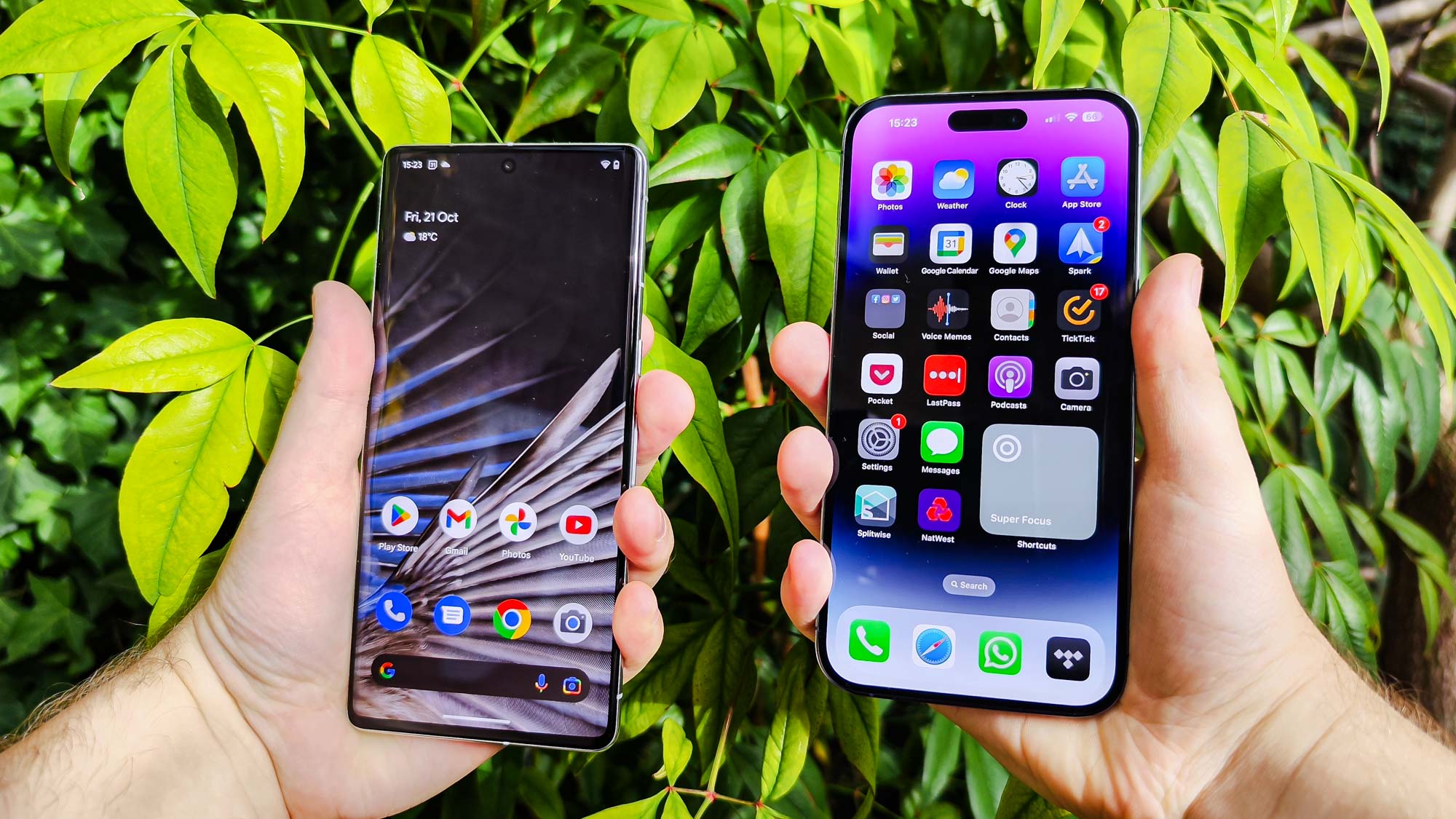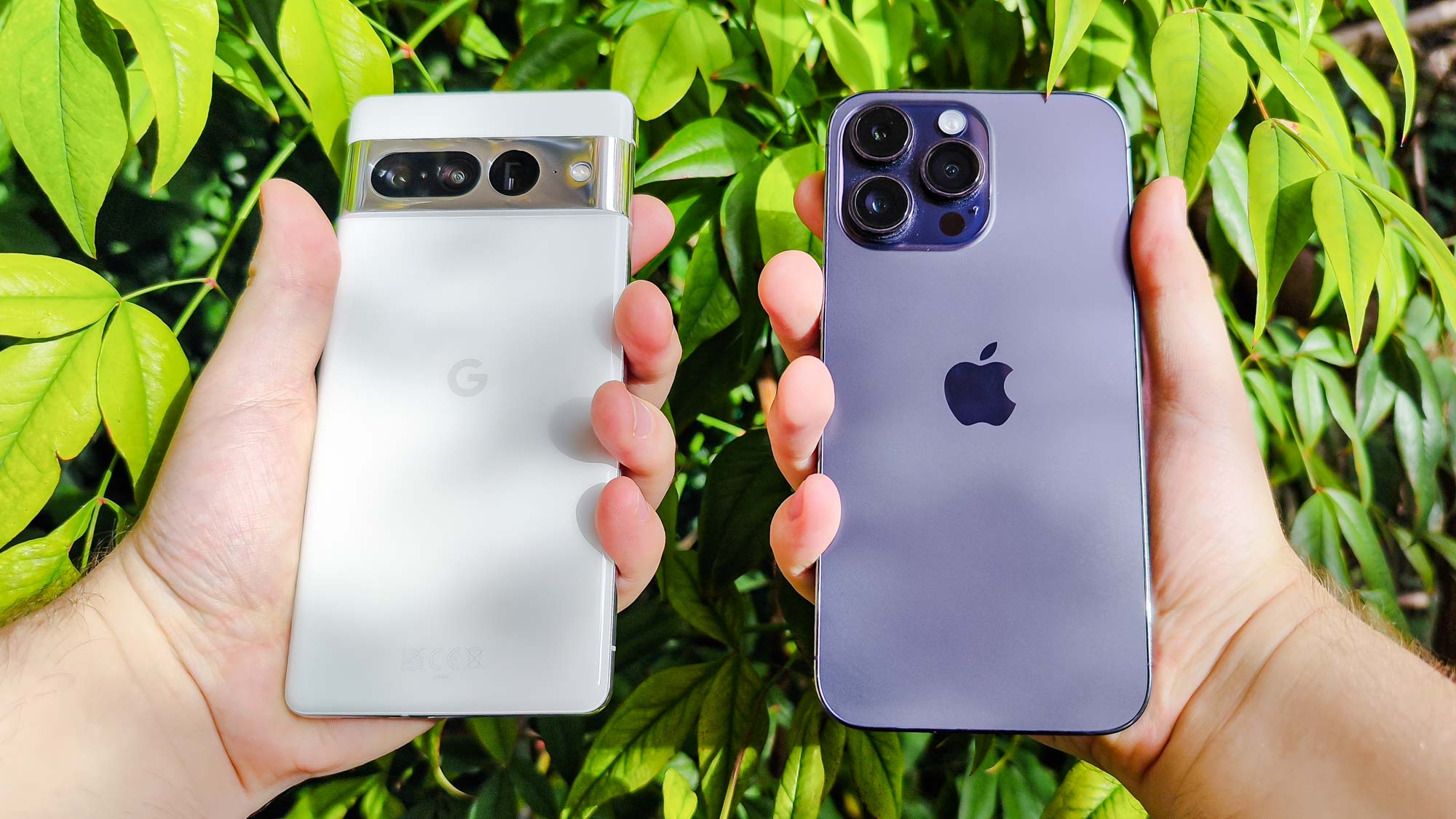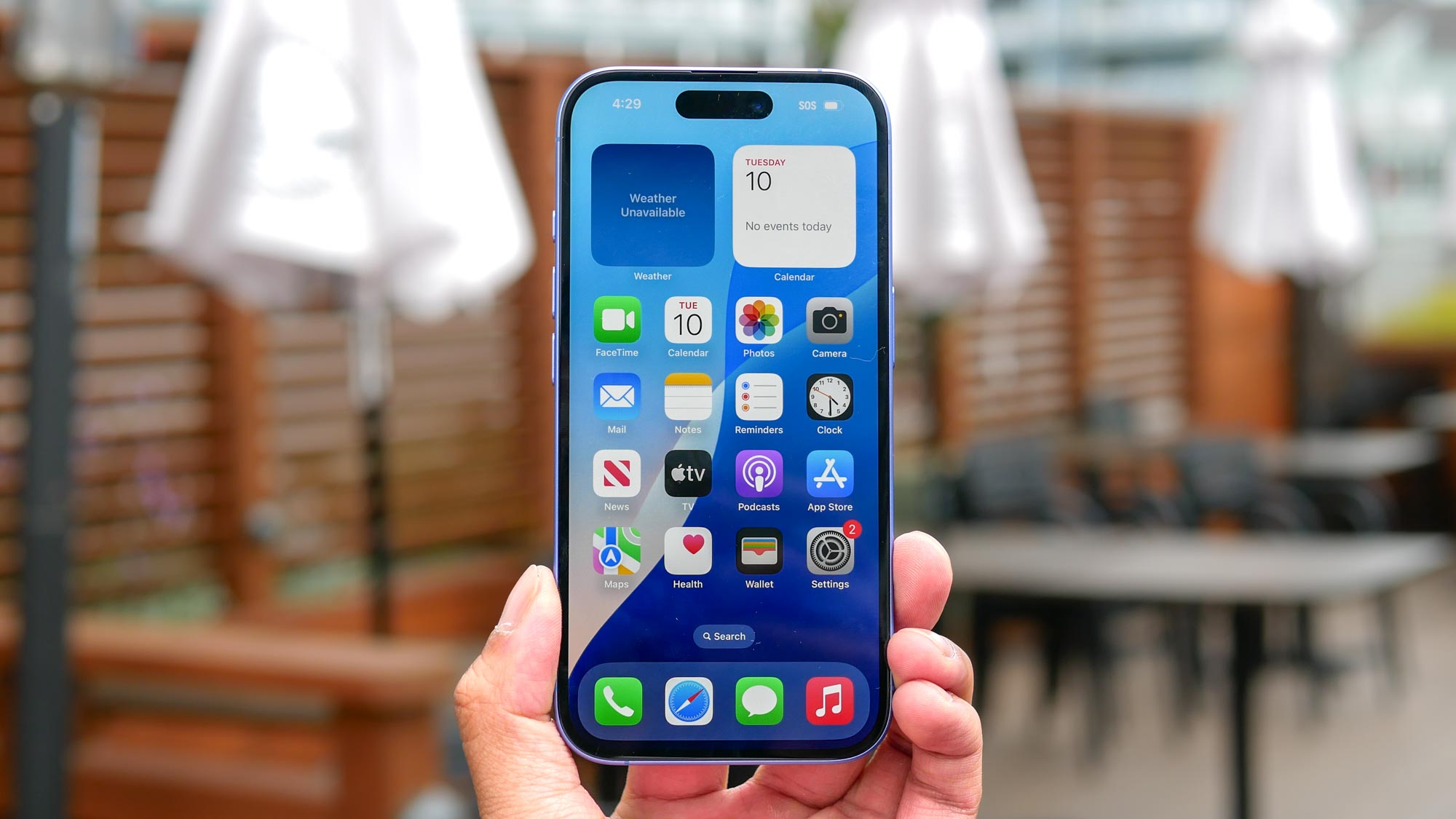Google Pixel 7 Pro vs. iPhone 14 Pro Max: Which flagship phone wins?
A Google Pixel 7 Pro vs iPhone 14 Pro Max comparison shows us two very different ways of making a premium smartphone. And the end result impresses in both cases

The Pixel 7 Pro is the newer of the pair, offering users some of the cleverest features and most powerful cameras on any Android phone, while still being much cheaper than its rivals. However, the iPhone 14 Pro Max is the pinnacle of Apple smartphones right now, meaning lots of computing power, an awesome display, an efficient battery and excellent photography, with all of that coming at a literal premium.
For users who just want the best phone for their money, whether that means using a phone with Android or iOS, picking between these two devices is a hard decision. But lucky for you, we've broken down all the key features of the phones so you can figure out who wins any Google Pixel 7 Pro vs. iPhone 14 Pro Max face-off.
Google Pixel 7 Pro vs. iPhone 14 Pro Max: Price and availability
Why you can trust Tom's Guide
The Pixel’s most appealing advantage over the iPhone is its price. While an iPhone 14 Pro Max will cost you $1,099 / £1,199 / AU$1,899, the Pixel 7 Pro starts at $899 / £849 / AU$1,299. That’s a significant difference if you’re trying to save your money.
Both phones are on sale right now, and the good news is that iPhone 14 delivery dates are becoming less lengthy, though it could still take around three weeks to get an iPhone 14 Pro Max. Pixel 7 Pro shipping dates could also take you a while right now, but will likely speed up faster than the iPhone's did right after launch.
Winner: Google Pixel 7 Pro
Google Pixel 7 Pro vs. iPhone 14 Pro Max: Design
Both the iPhone and the Pixel bear a strong resemblance to their predecessors. As a result, they look almost nothing alike beyond their rectangular frames.
Google kept its big Pixel 6 Pro redesign mostly intact on the Pixel 7 Pro, aside from swapping out the color options and improving on some materials. As such, there’s a metal camera bar on the back of the phone, stretching its entire width, and a curved display on the front with a small selfie camera punch-hole.

The iPhone 14 Pro Max is familiar to anyone who's seen the last couple of iPhone generations, but there are some differences still. The rear camera block is larger than ever before and the bezels are slightly slimmer. More significantly, instead of a notch there's a Dynamic Island that floats away from the edge of the phone and can change shape to show you key info from your active apps; it also houses the front camera and Face ID sensors.
It's definitely easier to hold the Pixel 7 Pro than the iPhone, as the curved back and screen make it less of an effort to reach across the display. That said, the iPhone's flat sides and Dynamic Island are just as unique among phones as the Pixel's camera bar is, so whichever phone you pick, it's going to make a statement.
Winner: Google Pixel 7 Pro
Google Pixel 7 Pro vs. iPhone 14 Pro Max: Display
Apple and Google both picked 6.7-inch displays for their latest phones but from there, things diverge.
The Pixel's display has curved sides as we mentioned, and offers a QHD resolution. The iPhone has a flat screen, a slightly lower display resolution (but not so much that you’d notice), and includes that Dynamic Island at the top taking up some space instead of a punch-hole cutout. Both phones feature adaptive 120Hz refresh rates.
| Row 0 - Cell 0 | Pixel 7 Pro | iPhone 14 Pro Max |
| Display size | 6.7 inches | 6.7 inches |
| sRGB (%) | 104.9 (Natural) | 117.5 |
| DCI-P3 (%) | 74.3 (Natural) | 83.2 |
| Delta-E (lower is better) | 0.28 (Natural) | 0.26 |
| Peak brightness (nits) | 927 | 1298 (SDR) / 1565 (HDR) |
In our display testing, we saw the iPhone bests the Pixel on every metric. Whether it’s color gamut coverage, color accuracy or overall brightness, the screen on the iPhone is better than the one on the Pixel 7 Pro.
Both phones also offer always-on displays, but they look quite different. The Pixel 7 Pro's AOD is a simple clock widget that appears in a single color, while the iPhone's is a dimmed version of your normal lock screen, including the clock, lock screen widgets and any notifications you have. It's a lot more thorough, but also far more distracting.
Winner: iPhone 14 Pro Max
Google Pixel 7 Pro vs. iPhone 14 Pro Max: cameras
The cameras on the iPhone and Pixel fill the same niches, and do so with similar sensors.
On the Pixel 7 Pro, you'll find a 50MP main camera, a 12MP ultrawide camera and a 48MP 5x optical telephoto camera; there’s an upgraded 10.8MP camera on the front. The iPhone 14 Pro Max meanwhile has a 48MP main camera, a 12MP ultrawide camera, a 12MP 3x optical telephoto camera and a 12MP selfie camera.
Comparing shots, there's a lot to like about both phones' cameras. Starting with these main camera shots of Camden's famous World's End pub, there's not much difference between the two. The iPhone has produced brighter highlights which I don't necessarily like, it’s also flattened the darker areas to better show off the textures, such on the wooden face of the building.
Turning the phones sideways to take this shot of the Boston Arms pub near Tuffnel Park at night, there's more of a difference. The iPhone's image looks a bit drab in comparison to the lively Pixel 7 Pro shot, although the light flares are more distracting on the Google-processed photo.
In this ultrawide shot of a bridge passing over Camden Market, we see that the iPhone better reproduced the lighting, particularly the shadow from nearby buildings falling onto the side of the bridge. I don't think the color is quite as natural as what the Pixel produced though.
There are two parts to this telephoto comparison so that we can assess the phones at their preferred zoom levels. First off, we have a 3x zoom shot of this giant boot hanging above a shop on Camden High Street. The image from the iPhone is sharper as you'd expect from a dedicated 3x lens, but the Pixel 7 Pro did a decent job with digital zoom from its main camera, although its image is a fair bit darker.
Next, a 5x shot, which is the magnification of the Pixel's telephoto camera. Here, the tables are turned, with the Pixel 7 Pro's image being sharper and brighter, and the iPhone's a bit fuzzier and dimmer, although still serviceable.
Lastly, we have a selfie portrait face-off. This is the only image where I'd say the iPhone's is without a doubt my favorite. As I've noticed when comparing previous iPhones and Pixels, Google's processing algorithm always produces a darker shot where I seem to have much more tanned skin, while the iPhone's image is brighter and more appealing, even if it has a tendency to make me look a bit too pink for my liking.
Beyond this though, both phones pick up the details in my face and blur the background equally competently, with the Pixel perhaps taking a slight edge due to its neater cutting out of me from the trees behind me.
Photo quality is a hard thing to declare a winner on, but aside from the selfie shot, I don't have a preference between these phones' cameras. These are undoubtedly two of the best camera phones you can buy right now, and you'd likely be happy with either one.
That is, unless you're planning to edit your shots, in which case there's more to discuss. The iPhone 14 Pro Max has an advantage in that it can produce 48MP ProRAW files for easier photo and video editing, and offers an Action Mode function for stabilized video recording. Google, however, gave the Pixel 7 the handy Magic Eraser and Photo Unblur tools for on-device touch-ups. Both phones also offer a "rack pull" effect when recording video, called Cinematic Mode on the iPhone and Cinematic Blur on the Pixel, for movie-like clips.
Winner: iPhone 14 Pro Max
Google Pixel 7 Pro vs. iPhone 14 Pro Max: performance
As is often the case when comparing an iPhone to an Android phone, Apple wins on performance by a country mile. The A16 Bionic chip with its 6GB RAM runs rings around the Tensor G2 chip in the Pixel, even though Google equips its Pro model with 12GB of RAM. You can see the whole story in the test results below.
| Row 0 - Cell 0 | Pixel 7 Pro | iPhone 14 Pro |
| CPU | Tensor G2 | A16 Bionic |
| Geekbench 5 (single-core / multicore) | 1060 / 3046 | 1882 / 5333 |
| 3DMark Wild Life Unlimited | 6275 / 40 | 8652 / 74 |
| 3DMark Wild Life Extreme Unlimited | 1805 / 11 | 2792 / 16.73 |
| Adobe Premiere Rush (Mins:Secs) | 0:47 | 0:26 |
For storage, both phones start at 128GB RAM, and offer 256GB options too. The iPhone 14 Pro Max goes further, though, with 512GB and 1TB options for users who want as much on-device storage as possible.
Winner: iPhone 14 Pro Max
Google Pixel 7 Pro vs. iPhone 14 Pro Max: Battery and charging
The Pixel 7 Pro has a much larger 5,000 mAh battery compared to the iPhone 14 Pro Max’s 4,323 mAh cell, but raw capacity doesn’t tell the whole story. The iPhone's tuned for far greater efficiency, as can be seen in our custom battery test results.
Apple’s phone lasted 13 hours and 39 minutes, placing it second overall on our best phone battery life list. That makes the Pixel 7 Pro’s time of 8 hours and 4 minutes especially disappointing. You'd get a lot more done in a busy day with the iPhone before it died than with the Pixel if you didn't have a charger nearby to help even the odds.
Speaking of charging, the iPhone offers 20W wired and 15W MagSafe wireless charging. The Pixel 7 Pro charges up to 30W wired and 23W wireless charging, which should get you filled up faster, even accounting for the difference in capacity.
Winner: iPhone 14 Pro Max
Google Pixel 7 Pro vs. iPhone 14 Pro Max: Software and special features
Apple launched the iPhone 14 Pro Max simultaneously with its latest iOS 16 software, while the Pixel 7 Pro came with the recently released Android 13. Both of these are effective operating systems, but they do behave very differently.
As for special abilities, the Pixel relies on its Tensor G2 chipset to enhance Google's Call Screen feature, which fight off robocalls before you pick up the phone. An upcoming Clear Call noise canceling capability should improve phone call audio, while smarter dictation, transcription and translation abilities are present, too.
Through iOS 16, the iPhone 14 Pro Max can do things like remove the subjects of photos out from the background for pasting elsewhere, track deliveries or sports scores through Live Activities, and customize multiple lock screens. The iPhone 14 Pro Max's own hardware also offers crash detection for the first time (something the Pixel series already offered prior to the Pixel 7), and, of course, Face ID unlocking.
The Pixel 7 comes with an under-display fingerprint reader, but it also technically offers facial recognition too with Face Unlock. It’s not fully secure though, so Google will sometimes force you to use your fingerprint to verify your identity when making payments, while Face ID lets you pass any security check the iPhone throws at you. Face Unlock on the Pixel still has its uses, such as for quickly unlocking the phone, but it’s not a true iPhone Face ID rival.
Google offers three years of software support, which is on the generous side for Android phones, adding to that five years of security patches and five years of access to the Google One VPN app. While Apple hasn’t officially announced the lifespan of iOS updates for the iPhone 14 Pro Max, we’d imagine it would get closer to five or six years of support based on the company’s track record.
Winner: Google Pixel Pro 7
Google Pixel 7 Pro vs. iPhone 14 Pro Max: Verdict
Cutting out any pre-existing hardware bias, it's difficult to pick a winner in the Google Pixel 7 Pro vs. iPhone 14 Pro Max battle. But looking at the scores below, we see that the iPhone takes the fight when you consider the bigger picture.
| Row 0 - Cell 0 | Google Pixel 7 Pro | iPhone 14 Pro Max |
| Price (10 points) | 10 | 6 |
| Design (10 points) | 9 | 8 |
| Display (15 points) | 12 | 14 |
| Cameras (20 points) | 18 | 19 |
| Performance (20 points) | 12 | 20 |
| Battery life and charging (15 points) | 11 | 13 |
| Special features/software (10 points) | 10 | 9 |
| Overall | 82 | 89 |
Google may well catch your eye with the Pixel 7 Pro’s lower price, plus its excellent photo capabilities, Tensor-powered smart features and faster charging. But you may be better off with the iPhone if you prioritize battery life, a more colorful display, long software support and processing power. The iPhone’s cameras aren’t anything to sneeze at, either.
To sum it all up, the Google Pixel 7 Pro is undoubtedly the better flagship phone deal. However, the iPhone 14 Pro Max remains the better smartphone overall.
If you’d like to save even more money over other flagships, then check out our Pixel 7 review. And see our Pixel 7 Pro vs Galaxy S22 Ultra face-off to see which flagship wins.
Next: Also check out our Google Pixel 7 Pro vs. iPhone 14 Pro vs. Galaxy S22 Ultra: ultimate zoom shootout.
Sign up to get the BEST of Tom's Guide direct to your inbox.
Get instant access to breaking news, the hottest reviews, great deals and helpful tips.
Philip Michaels is a Managing Editor at Tom's Guide. He's been covering personal technology since 1999 and was in the building when Steve Jobs showed off the iPhone for the first time. He's been evaluating smartphones since that first iPhone debuted in 2007, and he's been following phone carriers and smartphone plans since 2015. He has strong opinions about Apple, the Oakland Athletics, old movies and proper butchery techniques. Follow him at @PhilipMichaels.

